This Week in Toronto (Jan. 25 - 31)
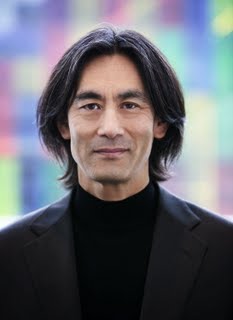 Conductor of MSO Kent Nagano
Conductor of MSO Kent NaganoLabels: Anita Rachvelishvili, Canadian Opera Company, Carmen, Kent Nagano, Montreal Symphony Orchestra, Olivier Messiaen, Rinat Shaham
 Conductor of MSO Kent Nagano
Conductor of MSO Kent NaganoLabels: Anita Rachvelishvili, Canadian Opera Company, Carmen, Kent Nagano, Montreal Symphony Orchestra, Olivier Messiaen, Rinat Shaham

Labels: Berlioz Requiem, Kent Nagano, Michael Schade, Michael Zaugg, Orchestre symphonique de Montreal, OSM, Place des Arts
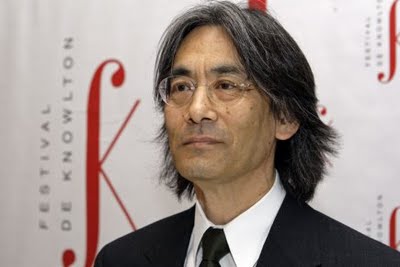
Labels: Festival de Knowlton, Juan-Noval Moro, June Anderson, Kent Nagano, Knowlton Festival, Marianne Lambert, Orfea and the Golden Harp, OSM, Sumi Jo, Susan Platts, Theatre Cotton Robes
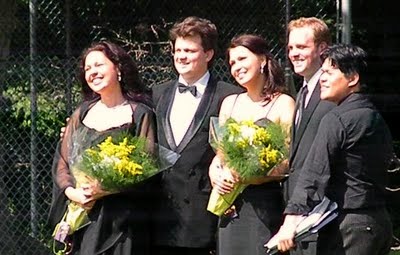
 The cast for the Tchaikovsky was headed by Ukrainian soprano Oksana Kramaryeva as Tatyana. I first heard her at Operalia in Québec City last September. At the time I was greatly impressed by the beauty of her voice and her command of phrasing, especially in an excerpt from Verdi’s Aïda. Last night, she was again impressive in the musical values of Tatyana’s great “Letter” aria. However, as we heard more of the opera, it seemed to me that she was underplaying the character. This is a deeply conflicted woman and her inner turmoil seldom bubbled to the surface in Kramaryeva’s performance. Baritone Christopher Magiera as Onegin also sang well and he was much more passionate. Tenor Dmitri Popov (photo: right) made an exceptionally heroic and ill-fated Lensky. Nagano kept it all flowing with total command of the score.
The cast for the Tchaikovsky was headed by Ukrainian soprano Oksana Kramaryeva as Tatyana. I first heard her at Operalia in Québec City last September. At the time I was greatly impressed by the beauty of her voice and her command of phrasing, especially in an excerpt from Verdi’s Aïda. Last night, she was again impressive in the musical values of Tatyana’s great “Letter” aria. However, as we heard more of the opera, it seemed to me that she was underplaying the character. This is a deeply conflicted woman and her inner turmoil seldom bubbled to the surface in Kramaryeva’s performance. Baritone Christopher Magiera as Onegin also sang well and he was much more passionate. Tenor Dmitri Popov (photo: right) made an exceptionally heroic and ill-fated Lensky. Nagano kept it all flowing with total command of the score.Labels: Christopher Magiera, Dmitri Popov, Festival de Knowlton, Kent Nagano, Knowlton Festival, Knowlton Festival Orchestra, Massimiliano Murrali, Oksana Krameryeva
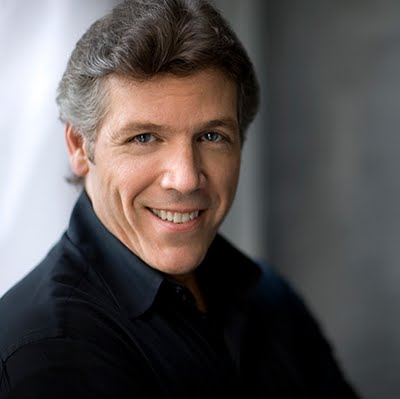 Last night at the Knowlton Festival, Kent Nagano continued his Brahms cycle with the OSM playing the Symphony No. 3 in F major Op. 90. The evening’s guest soloist was American baritone Thomas Hampson (photo: right) in three songs by Richard Strauss. It was arguably one of the best concerts of the festival.
Last night at the Knowlton Festival, Kent Nagano continued his Brahms cycle with the OSM playing the Symphony No. 3 in F major Op. 90. The evening’s guest soloist was American baritone Thomas Hampson (photo: right) in three songs by Richard Strauss. It was arguably one of the best concerts of the festival.Labels: Andrew Wan, brahms, Festival de Knowlton, Kent Nagano, Knowlton Festival, OSM, Richard Strauss, Thomas Hampson

 Performances of La Sonnambula are usually mounted as vehicles for star sopranos. There is no doubt that without a first-rate singer in the role of Amina, the production is unlikely to be successful. At last year’s festival, Sumi Jo (photo: right) was sensational in a concert of operatic excerpts and this year she easily topped that appearance. Her virtuosity was nearly impeccable and her soft singing, exquisite. In the tradition of the finest bel canto artists, she is able to use the ornamentation to convey the feeling of the moment, whether it be joy or sadness or something in between.
Performances of La Sonnambula are usually mounted as vehicles for star sopranos. There is no doubt that without a first-rate singer in the role of Amina, the production is unlikely to be successful. At last year’s festival, Sumi Jo (photo: right) was sensational in a concert of operatic excerpts and this year she easily topped that appearance. Her virtuosity was nearly impeccable and her soft singing, exquisite. In the tradition of the finest bel canto artists, she is able to use the ornamentation to convey the feeling of the moment, whether it be joy or sadness or something in between.Labels: Barry Banks, Bel Canto, Festival de Knowlton, Kent Nagano, Knowlton Festival, La Sonnambula, Orchestre symphonique de Montreal, OSM, Riccardo Zanellato, Sumi Jo, Vincenzo Bellini
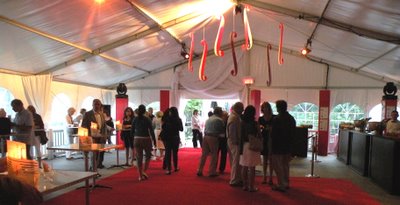 Knowlton was awash with tourists and classical music-lovers this weekend. The tourists are a familiar sight in these parts, drawn by the beauty of the location, the antique stores and boutiques selling lavender products and a tempting variety of other country fare. The music-lovers, however, are a relatively new phenomenon, attracted by the Knowlton Festival. On the basis of what I have heard so far I don’t think they would be disappointed.
Knowlton was awash with tourists and classical music-lovers this weekend. The tourists are a familiar sight in these parts, drawn by the beauty of the location, the antique stores and boutiques selling lavender products and a tempting variety of other country fare. The music-lovers, however, are a relatively new phenomenon, attracted by the Knowlton Festival. On the basis of what I have heard so far I don’t think they would be disappointed. 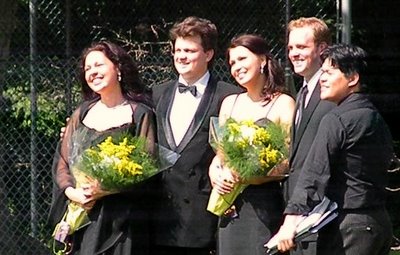
Labels: Ben Heppner, brahms, Bruno Cagli, Festival de Knowlton, handel, Kent Nagano, Knowlton Festival, Marco Genoni, Orchestre symphonique de Montreal
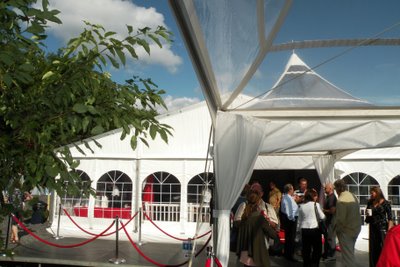 The Knowlton Festival, which started life as Festival Bel Canto last summer, opened officially last night with an all Brahms program. Maestro Kent Nagano did his best, in a well-attended pre-concert talk, to make the case that one could legitimately see the music of Brahms as no less bel canto than the operas of Rossini, Bellini and Donizetti. Basically, he was saying that all music is 'singing' or an attempt to emulate 'singing' using instruments. But such a broad definition obscures most of the very real and interesting differences between styles of music.
The Knowlton Festival, which started life as Festival Bel Canto last summer, opened officially last night with an all Brahms program. Maestro Kent Nagano did his best, in a well-attended pre-concert talk, to make the case that one could legitimately see the music of Brahms as no less bel canto than the operas of Rossini, Bellini and Donizetti. Basically, he was saying that all music is 'singing' or an attempt to emulate 'singing' using instruments. But such a broad definition obscures most of the very real and interesting differences between styles of music.
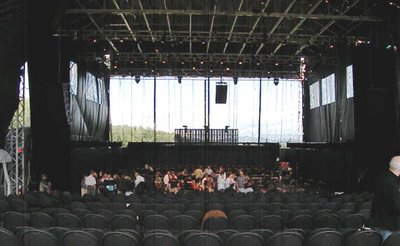 The festival tent is much larger than the one used last year. It is decidedly less claustrophobic and now has a bar area under cover. That it is still acoustically challenged should come as no surprise; it is still a tent and as such has no effective reflecting surfaces. Without amplification one guesses that very little sound would get to the audience.
The festival tent is much larger than the one used last year. It is decidedly less claustrophobic and now has a bar area under cover. That it is still acoustically challenged should come as no surprise; it is still a tent and as such has no effective reflecting surfaces. Without amplification one guesses that very little sound would get to the audience.Labels: brahms, Kent Nagano, Knowlton Festival, Marie-Nicole lemieux
 by Paul E. Robinson
by Paul E. Robinson Labels: Carlos Miguel Prieto, Gabriela Montero, Kent Nagano, Knowlton Festival, Orchestre symphonique de Montreal, Youth Orchestra of the Americas
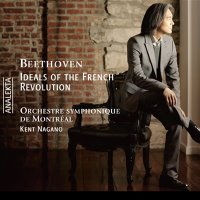 Maximilian Schell, narrator; Adrianne Pieczonka, soprano
Maximilian Schell, narrator; Adrianne Pieczonka, sopranoLabels: beethoven, classical CDs, english, Kent Nagano, OSM, product_review
Labels: Benjamin Britten, birthdays, composer, conductor, Kent Nagano, piano, viola